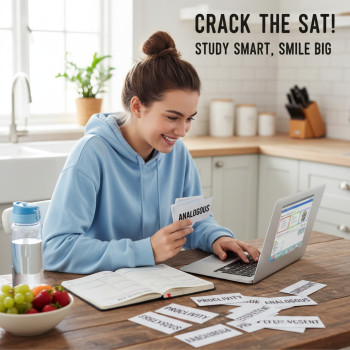Introduction: Why the SAT Still Matters in Hong Kong and Across Asia
When families in Hong Kong and across Asia talk about college applications, a few acronyms often float to the top of the conversation — UCAS, Common App, HKDSE, IB, and of course, the SAT. In recent years the SAT itself has evolved; the move to the Digital SAT has changed timing, format, and the way students prepare. But one question remains constant: can the SAT still help you get into top universities in Hong Kong, elsewhere in Asia, and beyond? Short answer: yes — if you understand how admissions teams use the test and plan strategically.

How Universities in Hong Kong and Asia View the SAT
Admissions practices vary widely. Some universities in Hong Kong and other parts of Asia treat the SAT as an important standardised measure that complements local qualifications (like HKDSE or national exams), while others place more emphasis on school transcripts, entrance exams, or interviews. International programs and universities with significant numbers of applicants from outside the host country often value SAT scores as a way to compare students from different educational systems.
Three common ways SAT scores are used
- Comparative academic evidence: SAT scores give admissions officers a consistent academic benchmark when applicants come from multiple curricula (IB, A‑levels, local diplomas).
- Scholarship and merit considerations: Strong SAT results can unlock merit scholarships or strengthen competitive financial award applications.
- Program fit and placement: Some departments may use SAT subscores (e.g., math) to inform placement or to flag readiness for advanced coursework.
Digital SAT: Key Differences That Matter to Asian Applicants
The Digital SAT is intentionally designed to be shorter, adaptive, and more reflective of real student skills. For students in Hong Kong and Asia, these practical changes have three big implications:
- Test timing and logistics: shorter total test time and more flexible test‑center scheduling can reduce conflict with local exams or school events.
- Adaptive format: the test adapts to your performance in real time — meaning strong initial performance can steer you to higher‑value questions and vice versa.
- Practice and familiarity: because the interface and question delivery differ from paper tests, targeted practice on digital platforms is essential.
Practical tip
Simulate test day on a laptop or school computer. The Digital SAT environment — screen size, navigation, time per question — affects pacing and accuracy. Practicing in the right format reduces surprises and boosts confidence.

When Should Hong Kong and Asian Students Take the SAT?
Timing matters. The right test schedule depends on your application timeline, other exams (HKDSE, A‑Levels, IB), and whether you plan to apply early or regular decision.
Suggested timeline examples
- Sophomore year (Year 11): Start familiarisation and diagnostic practice. Take a practice test and build a study plan.
- First half of junior year (Year 12): Take your first official Digital SAT if you plan to apply to U.S. or international programs the next year.
- Late junior year / early senior year: Re‑test if needed to improve subscores or overall results before applying.
For Hong Kong students who also sit HKDSE or other high‑stakes local exams, planning test dates around school commitments reduces stress. Building in a re‑test buffer is smart — many students improve with a second sitting after focused preparation.
How Much Does a Good SAT Score Help Your Application?
Think of the SAT as one chapter in your application book — an important one, but not the only one. A strong score can:
- Bolster academic credibility when your school’s curriculum is unfamiliar to a foreign admissions officer.
- Make you a more competitive candidate for scholarships.
- Help offset weaker grades in a particular year if the rest of your profile is strong.
When the SAT moves the needle most
- Applying to U.S. or highly selective international programs where standardized measures help admissions compare across systems.
- Applying to programs with many international applicants — a high SAT score can be an immediate filter that opens doors to interviews and offers.
- When you want scholarship consideration — many grants explicitly use standardized test results as part of selection criteria.
Creating a Practical Study Roadmap
Good preparation blends strategy with consistent practice. Below is a sample 4‑month roadmap that mixes content review, skill building, and digital practice.
| Month | Focus | Weekly Plan |
|---|---|---|
| Month 1 — Diagnostic & Basics | Take a full Digital SAT diagnostic; identify strengths and weaknesses | 2 practice sections, 3 content review sessions, 1 timed digital practice |
| Month 2 — Skill Building | Target weak areas, build vocabulary and algebra fundamentals | 4 focused practice sets, 1 full section under timed conditions |
| Month 3 — Strategy & Pacing | Learn question navigation, adaptive behavior, and time management | 2 full Digital practice tests, 2 strategy sessions, 2 review sessions |
| Month 4 — Final Polishing | Full practice tests, test‑day routine, and mental prep | 2 full tests, 3 light review sessions, simulated test day |
Why a tailored plan matters
Students in different curricula (IB vs. HKDSE vs. A‑Levels) will have varying strengths. A student strong in essay writing but weak in algebra needs a different mix of study than someone with the opposite profile. That’s where personalised tutoring, like Sparkl’s 1‑on‑1 guidance and tailored study plans, can fit naturally — a tutor can build a plan that reflects your school schedule, strengths, and university goals.
Pacing, Time Management, and the Adaptive Section
The adaptive nature of the Digital SAT means time management is both more and less forgiving. You won’t see the exact same set of questions as another test taker, and the test may route you based on earlier answers. That makes strategy crucial:
- Answer accurately — early correct answers tend to feed higher‑value questions.
- Skip wisely — if a question is taking too long, flag it and move on; return if you have time.
- Practice on the device you’ll use — comfort with keyboard navigation, on‑screen calculators, and highlighting tools saves seconds that add up.
Practice exercise
During practice, deliberately simulate early mistakes and see how the subsequent sections feel. This helps you build resilience: if an early block goes poorly, you’ll be equipped to reset and focus on recovery questions instead of spiraling.
Application Strategy: Combining SAT with Local Credentials
In Hong Kong and much of Asia, students often apply with strong local exam results. How do you present both effectively?
- Use the SAT to complement, not replace, your local credentials. In your application, present SAT as a standardized measure and explain any curriculum differences in your personal statement or additional information section.
- Highlight subject alignment. If applying for engineering, emphasize high math subscores; for economics, point to evidence in math and reading/writing.
- Contextualize grades. Where possible, explain the rigor of your program and any grade trends (for example, an upward trajectory) in your school profile or counselor recommendation.
Example approach
A student with excellent HKDSE results and a strong SAT math score should stress quantitative readiness in both the application and any departmental essays. If their reading score is comparatively lower, they can strengthen the profile with a compelling personal statement, teacher recommendations that highlight communication skills, or relevant extracurriculars.
Scholarships and Financial Aid — Where the SAT Helps
Many merit awards for international students consider standardized test results. A high SAT can:
- Qualify you for institution‑level merit scholarships.
- Make you eligible for certain external scholarships that list test score thresholds.
- Enhance your negotiation power for financial support at schools that use multi‑factor offers.
Note: scholarship formulas vary. Always check each university’s latest admissions and scholarship policy (or contact their admissions office) to understand how scores are weighed.
Common Mistakes Students from Hong Kong and Asia Make — And How to Fix Them
- Over‑relying on content knowledge: the SAT rewards reasoning and timing as much as raw content. Train for strategy, not just facts.
- Poor practice format: practising only on paper or mobile phones when the test will be taken on a laptop can create unnecessary friction.
- Last‑minute cramming: the Digital SAT favors consistent, spaced practice. Build endurance and strategy over months, not days.
- Undervaluing the personal statement: a strong SAT won’t substitute for a weak narrative. Tell your story authentically.
How Parents Can Support Without Micromanaging
Parents often wonder how hands‑on to be. Helpful support looks like this:
- Provide scheduling support: help students block out regular study time around school commitments and exam seasons.
- Encourage balanced routine: sleep, nutrition, and short digital‑free breaks improve focus and retention.
- Invest in smart resources: targeted tutoring sessions (for example, occasional 1‑on‑1 coaching with providers like Sparkl) can address weak points faster than generic courses.
- Stay informed: know application deadlines (school, scholarship, and test date windows) and help the student plan accordingly.
Real‑World Stories: How Students Turned SAT Strategy Into Offers
Here are two short examples drawn from common real‑world patterns (anonymized and composite):
Case 1 — The Late Bloomer
Background: A student strong in sciences but with inconsistent school grades. Strategy: Took a diagnostic, focused on fixing timing and algebra weakness over three months, then took the SAT. Result: Improved math subscore by 80 points; the higher math score opened doors to engineering scholarships and an interview.
Case 2 — The Busy Multitasker
Background: A student juggling IB internal assessments and extracurricular leadership. Strategy: Used short, targeted practice sessions that fit weekly; used a tutor for three focused 1‑on‑1 sessions to refine essay strategies and pacing. Result: Achieved a balanced score, used SAT as part of holistic application to an overseas university program, and received an offer with partial scholarship.
Checklist: What to Do in the Month Before Your Digital SAT
- Take one final full digital practice test under test‑day conditions.
- Review error patterns rather than learning new content.
- Confirm test day logistics: travel, ID documents, and arrival time.
- Pack a light snack, a charged device if permitted, and familiar comfort items (earplugs, wristwatch if allowed by rules).
- Plan one rest day before the test for mental freshness.
How Personalized Tutoring Can Make a Difference
Generic prep resources are useful, but many students find the biggest score gains come from targeted, personalised coaching. A tutor who understands the Digital SAT interface, the student’s school curriculum, and university goals can:
- Create a tailored study plan that fits around HKDSE, IB, or A‑Level timelines.
- Provide focused 1‑on‑1 practice to shore up specific weaknesses (for example, SAT data analysis or advanced algebra tactics).
- Offer AI‑driven insights to identify question patterns and efficient practice strategies, paired with human feedback for motivation and exam strategy.
If you’re considering support, Sparkl’s personalised tutoring model — 1‑on‑1 guidance, tailored study plans, expert tutors, and AI‑driven insights — is one example of how a smart, tailored approach can fit into a busy academic life and help translate hard work into an application advantage.
Table: Quick Comparison — SAT, HKDSE, IB (For Context)
| Exam | Primary Use | Strengths | How SAT complements it |
|---|---|---|---|
| SAT (Digital) | International university admissions, scholarships | Standardised comparison across systems, reasoning skills | Provides a neutral benchmark for international applicants |
| HKDSE | Local university admissions in Hong Kong | In‑depth local curriculum coverage | Shows curriculum mastery; SAT adds comparative context |
| IB Diploma | International admissions and credit | Holistic, rigorous coursework and TOK/EE components | High SAT can strengthen scholarship or program placement |
Final Thoughts: A Practical, Calm Approach Wins
Applying to universities from Hong Kong or elsewhere in Asia can feel like navigating multiple systems at once. The Digital SAT is a tool — often a powerful one — but it works best as part of a balanced application strategy. Plan test timing around local exams, practise in the digital format, and balance test prep with strong personal statements, recommendations, and extracurricular evidence.
Remember: incremental, focused work beats last‑minute pressure. A blend of self‑study and occasional personalised support (for example, Sparkl’s 1‑on‑1 coaching and tailored plans) often gives students the confidence and results they need. Start early, measure progress, and give yourself space to grow.
Quick Resources and Next Steps
To get moving today:
- Schedule a diagnostic Digital SAT practice test on a laptop in a quiet space.
- Create a realistic weekly plan with short, focused sessions and one longer weekly practice.
- Consider one or two targeted tutoring sessions to refine strategy and pacing — especially if you’re balancing local exams.
- Build a portfolio of personal statements, teacher recommendations, and a clear list of target programs so your test strategy aligns with your application goals.
Closing
For students and parents in Hong Kong and across Asia, the Digital SAT is less a gatekeeper and more a bridge — a standardised signal that speaks across curricula and borders. With the right plan, practice, and occasional personalised guidance, it can open doors not just to universities but to scholarships and programs that match each student’s unique strengths. Take a breath, make a plan, and then take the next step — one confident practice session at a time.














No Comments
Leave a comment Cancel